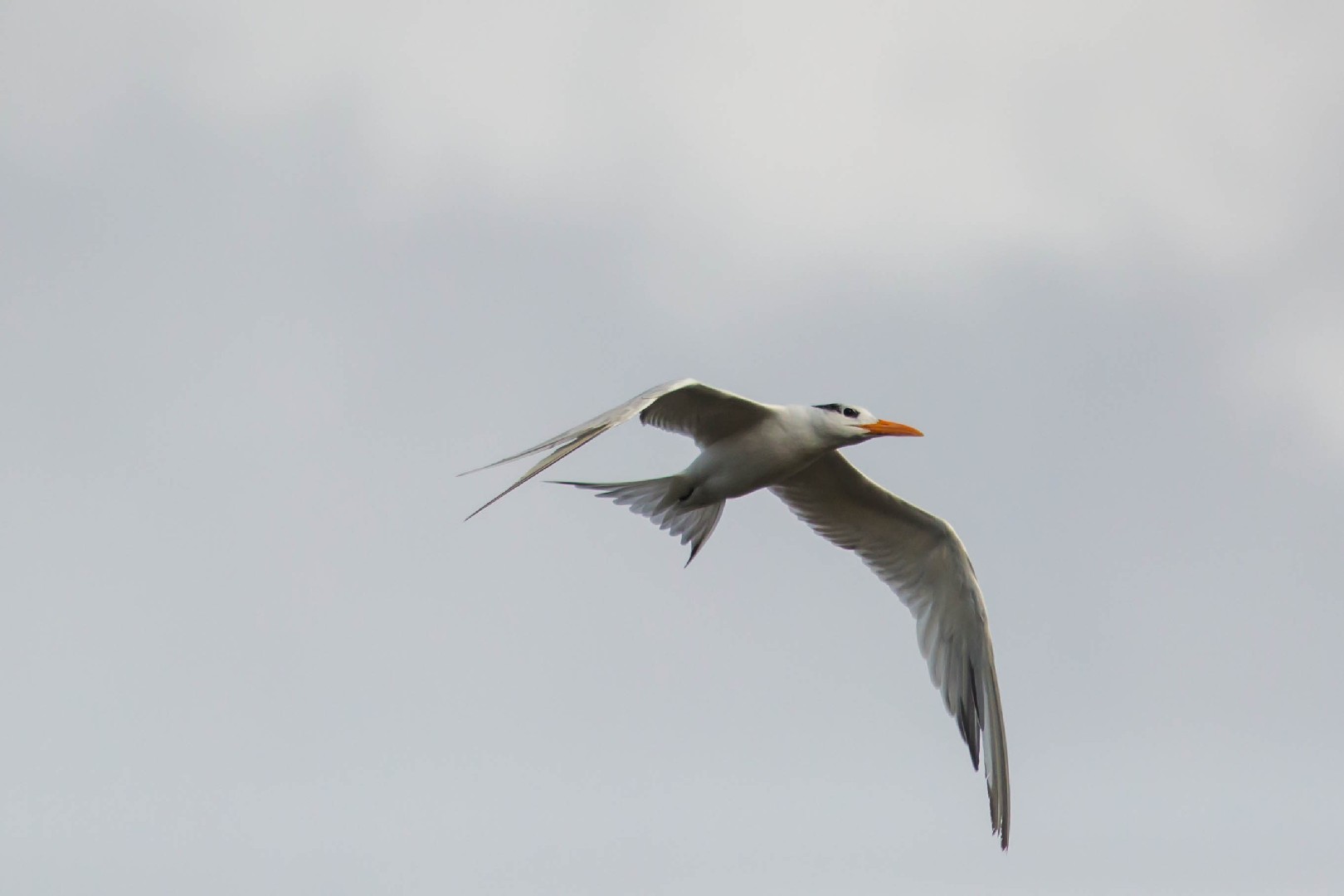Royal Tern
A species of Crested terns Scientific name : Thalasseus maximus Genus : Crested terns
Royal Tern, A species of Crested terns
Botanical name: Thalasseus maximus
Genus: Crested terns
Content
Description People often ask General Info
Description
This is a large tern, second only to Caspian tern but is unlikely to be confused with the carrot-billed giant, which has extensive dark under wing patches. The royal tern has an orange-red bill, pale grey upper parts and white under parts. Its legs are black. In winter, the black cap becomes patchy. Juvenile royal terns are similar to non-breeding adults. Differences include juveniles having black splotched wings and a yellower bill. An adult royal tern has an average wingspan of 130 cm (51 in), for both sexes, but their wingspan can range from 125–135 cm (49–53 in). The royal tern's length ranges from 45–50 cm (18–20 in) and their average weight is anywhere from 350–450 g (12–16 oz). The calls of the royal tern are usually short, clear shrills. Some of the shrills sound like kree or tsirr; the royal tern also has a more plover like whistle that is longer, rolling and is more melodious. In various parts of its range, the royal tern could be confused with the elegant tern, lesser crested tern (the other orange-billed terns), and the greater crested tern. It is paler above than lesser crested tern and the yellow-billed great crested tern. The elegant tern has a longer more curved bill and shows more white on the forehead in winter. 
Size
46 - 53 cm
Colors
Black
Gray
White
Life Expectancy
17 years
Nest Placement
Ground
Clutch Size
1 - 2 eggs
Incubation Period
1 brood
Number of Broods
28 - 31 days
Nestling Period
28 - 35 days
Feeding Habits
Royal Tern primarily consume small fish like anchovies, sardines, and bluefish, along with shrimp and crabs, catching them via 30-foot-high plunge-diving. Foraging occurs in various-sized groups, typically over shallow waters such as estuaries, and occasionally at night for squid. They often feed near colonies but can travel far and typically swallow prey mid-flight.
Habitat
Royal Tern predominantly reside in coastal environments, favoring sandy beaches, harbors, and estuaries. They are adapted to warm, marine conditions and are usually found in areas close to shorelines. While rearing their young, royal Tern may travel more than 50 miles offshore or along inland saltwater bays and rivers. Post-hurricane events can occasionally disperse them into interior regions of North America.
Nest Behavior
Nesting involves ground site selection, digging, synchronous egg-laying, and both parents incubating the eggs and caring for the fledglings.
Nest Characteristics
Royal Tern's nest is an unlined depression in sand, chosen on beaches or islands. Males and females collaborate to form it with feet and body, marked by defecation along the rim.
Dite type
Piscivorous
General Info
Feeding Habits
Bird food type
Sounds
Call
Recording location: United States
JuvenileCall
Recording location: United States
Behavior
Royal Terns exhibit both solitary and social tendencies. During nesting, they form dense colonies but display territorial behaviors in courtship. Males court females with aerial displays and gift exchanges, such as offering a fish mid-flight. On land, the presentation of prey items and mutual preening reinforce pair bonds. Royal Terns are mostly monogamous and both parents are involved in incubation and chick-rearing. Post-hatching, young royal Terns may be aggressively defended from neighboring chicks but are eventually grouped into crèches, reducing parental aggression. These birds continue to feed fledglings for several months, even after migrating to wintering grounds. Outside breeding, they show gregariousness, often mingling with other seabirds.
Distribution Area
In the Americas, the royal terns on the east coast, during the breeding season (April to July), occur in the US north to Virginia, occasionally drifting north to Long Island, New York. The southern end of their breeding range is Texas. The wintering range on the east coast is from North Carolina south to Panama and the Guianas, also the Caribbean islands. On the western coast of the Americas, the royal tern spends the breeding season from the US state of California to Mexico, wintering from California south to Peru. American birds migrate south to Peru and Argentina for the winter to escape the cold weather. African birds may reach as far north as Spain. This species has also wandered to Western Europe as a rare vagrant, these terns are probably from the American colonies. 
Species Status
The royal tern is one of the species addressed in the Agreement on the Conservation of African-Eurasian Migratory Water Birds (AEWA). The AEWA covers 255 species that depend on wetlands for part of their life. The AEWA covers birds from 64 countries in Africa and Eurasia. There are little other conservation efforts because the royal tern's status is of least concern. The reason there is little concern for the extinction of the royal tern is that the species has not experienced a significant enough decrease in population to become threatened or endangered. 
